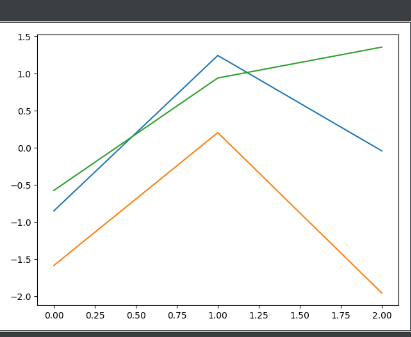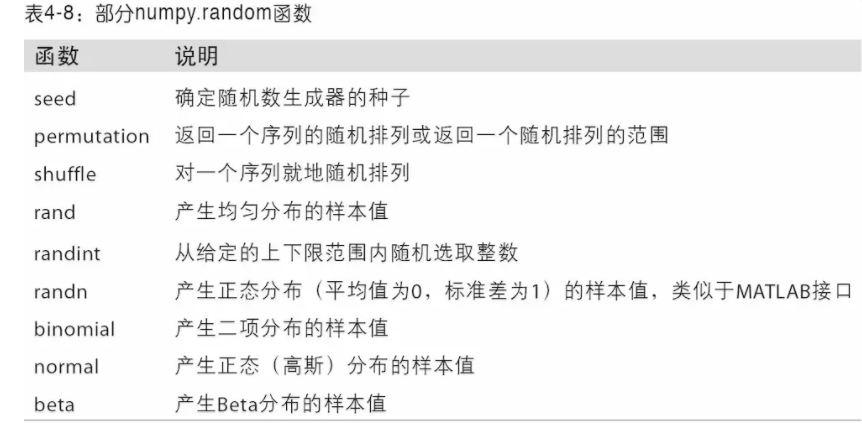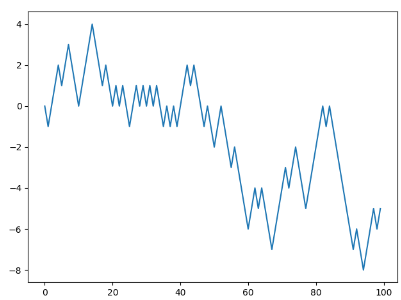内容学习自:
Python for Data Analysis, 2nd Edition
就是这本
纯英文学的很累,对不对取决于百度翻译了
前情提要:
各种方法贴:
https://www.cnblogs.com/baili-luoyun/p/10250177.html
本节内容,numpy 结尾, 以及pands初入门
一:伪随机函数
samples =np.random.normal(size=(3,3))
print(samples)
samples1 =np.random.seed(1234) #调节随机种子
print(samples1)
>>>>
[[ 0.91041087 0.99724402 -0.0681944 ]
[ 0.48277059 -1.50446272 0.30656754]
[-0.01929894 -0.27835256 -0.68331925]]
None
2>:给上下限的数取整
samplse1 = np.random.randint(1,6) #给上下限的数取整数
print(samplse1)
.>>>.>>>>>
# 随机整数
2
3>:产生正太分布样本
arr1 =np.random.randn(3,3) #产生正态分布的样本值
print(arr1)
>>>>>
[[ 0.55526507 -0.3952732 1.49921319]
[-0.06943318 -0.05375604 -0.26636376]
[-1.48909115 -0.00702559 0.15973251]]

4>:产生均匀分布样本
arr1 =np.random.rand(3,3) #产生均匀分布的样本质
print(arr1)
>>>
[[0.56847387 0.23533505 0.97136229]
[0.0049996 0.60753788 0.20997453]
[0.41777576 0.26264969 0.55777828]]


二:随机漫步
1:单随机漫步(普通方法)
import matplotlib.pylab as plt
import random
postition = 0
walk =[postition]
steps =1000
for i in range(steps):
step = 1 if random.randint(0,1) else -1
postition += step
walk.append(postition)
print(walk)
plt.plot(walk[:100])
plt.show()
>>>>>>
[0, 1, 0, 1, 2, 1, 0, -1, 0, -1, -2, -3, -4, -5, -6, -5, -6, -5, -6, -7, -8, -7, -8, -7, -8, -7, -6, -5, -6, -7, -6, -7, -8, -7, -8, -9, -8, -7, -6, -5, -6, -5, -4, -3, -4, -3, -2, -3, -4, -5, -4, -5, -4, -5, -6, -5, -4, -3, -4, -5, -4, -3, -2, -3, -2, -1, -2, -1, -2, -3, -4, -5, -4, -3, -2, -3, -4, -3, -2, -1, 0, 1, 0, -1, 0, -1, 0, 1, 2, 3, 4, 5, 4, 3, 2, 3, 2, 1, 2, 1, 0, 1, 2, 3, 4, 3, 4, 3, 4, 3, 4, 3, 4, 5, 4, 5, 6, 7, 6, 5, 4, 3, 2, 1, 2, 3, 4, 3, 4, 5, 6, 5, 4, 5, 4, 5, 6, 5, 6, 5, 4, 3, 2, 1, 2, 1, 0, 1, 0, -1, 0, 1, 0, -1, -2, -1, -2, -1, 0, 1, 2, 3, 4, 5, 4, 5, 4, 3, 4, 5, 6, 7, 8, 7, 6, 5, 4, 5, 6, 7, 6, 7, 6, 7, 8, 9, 10, 9, 8, 9, 8, 9, 10, 11, 10, 11, 12, 11, 10, 9, 10, 9, 8, 7, 8, 7, 6, 5, 4, 5, 4, 3, 2, 1, 0, 1, 0, 1, 2, 1, 0, -1, 0, -1, -2, -3, -2, -1, 0, 1, 0, 1, 0, -1, 0, 1, 0, -1, -2, -3, -2, -3, -2, -3, -4, -3, -2, -3, -4, -3, -2, -3, -4, -3, -4, -3, -2, -3, -4, -3, -4, -5, -6, -7, -6, -7, -8, -9, -10, -9, -8, -7, -8, -9, -10, -11, -12, -13, -14, -15, -14, -15, -14, -15, -14, -13, -12, -13, -14, -13, -14, -15, -16, -17, -18, -17, -18, -19, -18, -19, -20, -19, -18, -17, -16, -15, -14, -13, -12, -11, -12, -13, -12, -13, -12, -11, -10, -9, -8, -9, -8, -7, -8, -9, -10, -9, -10, -11, -12, -13, -12, -13, -14, -13, -12, -13, -14, -15, -14, -13, -12, -11, -12, -13, -12, -13, -12, -13, -14, -13, -14, -15, -14, -15, -16, -17, -16, -15, -16, -15, -16, -15, -16, -17, -18, -17, -18, -19, -18, -17, -16, -15, -14, -15, -14, -15, -16, -17, -18, -19, -20, -21, -20, -21, -20, -19, -20, -19, -18, -19, -18, -17, -16, -17, -16, -15, -16, -15, -14, -15, -14, -15, -14, -15, -16, -15, -14, -15, -16, -17, -16, -15, -16, -15, -16, -17, -16, -15, -14, -13, -14, -15, -14, -13, -14, -15, -16, -17, -16, -15, -14, -13, -12, -13, -14, -15, -14, -15, -14, -13, -12, -11, -12, -11, -12, -13, -14, -13, -12, -13, -12, -13, -14, -13, -14, -15, -14, -15, -14, -13, -12, -13, -14, -15, -14, -15, -16, -15, -16, -17, -18, -17, -18, -17, -18, -17, -18, -17, -18, -19, -18, -19, -18, -17, -18, -19, -20, -19, -18, -19, -18, -17, -16, -15, -14, -15, -16, -15, -14, -15, -16, -15, -16, -15, -14, -13, -12, -11, -12, -11, -10, -11, -12, -13, -14, -13, -12, -11, -10, -11, -10, -11, -12, -13, -14, -15, -14, -15, -14, -15, -16, -17, -16, -17, -18, -17, -18, -17, -16, -15, -14, -15, -14, -15, -16, -15, -14, -15, -16, -17, -18, -19, -20, -21, -20, -19, -18, -19, -18, -17, -18, -19, -18, -19, -18, -19, -20, -19, -18, -19, -20, -19, -20, -19, -18, -19, -20, -21, -22, -21, -22, -23, -22, -21, -20, -21, -20, -21, -22, -21, -20, -19, -18, -19, -18, -19, -18, -17, -18, -19, -20, -21, -20, -21, -22, -23, -24, -23, -22, -21, -20, -19, -20, -19, -18, -17, -18, -17, -18, -19, -20, -21, -20, -19, -18, -19, -20, -21, -22, -23, -22, -23, -22, -21, -20, -21, -22, -23, -24, -25, -24, -25, -24, -25, -24, -25, -26, -25, -24, -25, -26, -25, -26, -27, -28, -29, -30, -29, -30, -31, -32, -33, -34, -33, -32, -33, -34, -33, -34, -33, -32, -31, -30, -29, -30, -31, -30, -31, -30, -29, -28, -27, -26, -27, -28, -27, -26, -25, -24, -25, -26, -25, -24, -25, -24, -23, -22, -23, -22, -21, -20, -21, -20, -21, -20, -19, -20, -19, -20, -21, -22, -21, -20, -19, -20, -19, -18, -19, -18, -17, -16, -15, -16, -17, -18, -19, -20, -21, -22, -23, -22, -23, -24, -25, -26, -27, -28, -29, -28, -27, -28, -27, -26, -25, -24, -25, -26, -27, -26, -27, -26, -25, -24, -23, -24, -25, -24, -25, -26, -25, -26, -27, -28, -27, -26, -27, -26, -25, -24, -25, -26, -25, -26, -27, -28, -27, -28, -27, -26, -27, -26, -27, -26, -25, -24, -25, -24, -23, -22, -21, -20, -21, -20, -21, -22, -21, -20, -21, -20, -19, -20, -21, -20, -19, -20, -21, -22, -23, -24, -23, -22, -21, -22, -23, -24, -25, -26, -25, -24, -23, -24, -23, -22, -23, -22, -23, -22, -21, -20, -21, -22, -23, -24, -23, -22, -21, -22, -21, -22, -21, -20, -19, -20, -19, -20, -21, -22, -21, -20, -19, -18, -19, -18, -17, -18, -19, -20, -19, -20, -21, -20, -19, -20, -19, -18, -19, -20, -19, -20, -19, -18, -19, -18, -17, -18, -17, -18, -19, -18, -17, -16, -15, -16, -15, -16, -15, -14, -15, -16, -17, -18, -19, -20, -19, -18, -17, -16, -17, -18, -19, -20, -21, -20, -19, -20, -21, -20, -21, -20, -21, -22, -21, -20, -19, -20, -21, -20, -19, -20, -21, -22, -21, -22, -23, -24, -23, -24, -23, -24, -23, -24, -25, -26, -27, -28, -27, -28, -29, -30, -29, -28, -27, -26, -27, -26, -27, -28, -29, -28, -27, -26, -27, -28, -29, -30, -29, -30, -31, -32, -31, -32, -31, -30, -29, -30, -31, -30, -29, -28, -29, -30, -29, -28, -27, -28, -27, -26, -25, -26, -25, -26, -25, -24, -25, -26, -27, -26, -27, -26, -25, -24, -25, -26, -25, -24, -25, -24, -23, -22, -23, -24]

2:利用numpy随机漫步
1>:生产1个0 或者1 的1维矩阵,1000次
nsteps =1000
draws =np.random.randint(0,2,size=nsteps) #生成一个0 或者1 的1位矩阵,1000次
print(draws)
>>>>
[1 1 1 0 1 1 1 0 1 0 0 0 1 1 1 1 0 1 0 1 0 1 0 1 0 0 1 0 0 0 0 0 1 1 1 0 0.............. 0 1 1 1 0 1 1 1 1 1 1 0 1 0 0 1 0 1 1 1 0 0 0 1 0 1 0 0 0 0 1 0 0 1 1 0 1
1]
2>:进行三元运算累加
nsteps =1000
draws =np.random.randint(0,2,size=nsteps) #生成一个0 或者1 的1位矩阵,1000次
# print(draws)
steps =np.where(draws>0 ,1,-1) #三元运算
walk =steps.cumsum() #累加
print(walk)
plt.plot(walk)
plt.show()
>>>>>>>>>>
[ 1 0 -1 0 -1 0 -1 0 1 0 1 2 3 4 3 4 5 6
5 6 5 4 5 6 7 6 7 8 9 10 11 10 11 12 11 10
11 12 11 12 11 12 13 14 13 12 13 14 15 16 15 16 17 18
17 18 17 18 19 18 17 16 15 14 15 16 17 16 15 14 13 12
11 10 9 10 9 10 9 10 9 10 9 10 11 10 11 12 11 10
9 10 11 12 11 10 9 10 11 10 9 8 9 8 9 8 9 8
.......

2.1>最大值 ,最小值
l1 =walk.min() # 最小值
print(l1)
l2 =walk.max() #最大值
print(l2)
>>>>>>
-51
12
2.2>求距离0 到(+,-)10 距离最近的索引
l =(np.abs(walk)>=10).argmax() #求距离0 位置10个距离的索引
print(l)
\>>>>>>>>>>>>>>
35
3:模拟多次随机漫步
nwalks =5000 #组数 nsteps =1000 #步数 draws =np.random.randint(0,2,size=(nwalks,nsteps)) # 生成1,0 内的随机5000个漫步值 print(draws) steps =np.where(draws>0 ,1,-1) walks =steps.cumsum(1) print(walks) >>>> [[1 1 1 ... 1 0 1] [0 0 0 ... 0 1 1] [1 0 0 ... 0 1 0] ... [0 0 0 ... 1 0 0] [1 1 0 ... 0 1 1] [1 0 1 ... 0 0 1]] [[ 1 2 3 ... 54 53 54] [ -1 -2 -3 ... -50 -49 -48] [ 1 0 -1 ... -34 -33 -34] ... [ -1 -2 -3 ... -64 -65 -66] [ 1 2 1 ... -8 -7 -6] [ 1 0 1 ... -8 -9 -8]]